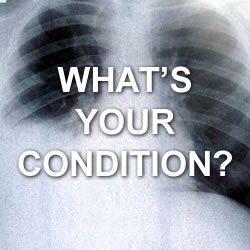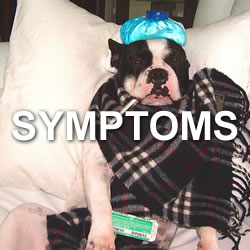Infections
It is a fair, even-handed, noble adjustment of things, that while there is infection in disease and sorrow, there is nothing in the world so irresistibly contagious as laughter and good-humor - Charles Dickens

image by: Arlington County
HWN Suggests
Simple Choices to Limit the Spread of Infectious Disease
"I'm only going to stay for a minute, because I'm very contagious," she said before chatting and staying for closer to five, thus knowingly exposing the nine healthy people in the room to her influenza without making any effort to minimize our risk.
Her presence was perfectly legitimate: this was a homeowners' association (HOA) meeting, and she was a resident dropping off something to the property manager. So perhaps my increasing annoyance was uncharitable. But she was fully conscious of her status as a carrier, so why wasn't she limiting our exposure, as she supposedly had in mind to do?
Staying no longer than necessary would have…
Resources
 CIDRAP
CIDRAP
The Center for Infectious Disease Research and Policy (CIDRAP; "SID-wrap") is a global leader in addressing public health preparedness and emerging infectious disease response. Founded in 2001, CIDRAP is part of the Academic Health Center at the University of Minnesota.
 HealthMap
HealthMap
HealthMap brings together disparate data sources to achieve a unified and comprehensive view of the current global state of infectious diseases and their effect on human and animal health. This freely available Web site integrates outbreak data of varying reliability, ranging from news sources (such as Google News) to curated personal accounts (such as ProMED) to validated official alerts (such as World Health Organization).
 Infectious Agents
Infectious Agents
People get sick when another organism, big or small, invades their body and infects them. These infectious agents come in all shapes and sizes, and all of them pose different threats to the human body. Some are microscopic, such as bacteria or viruses, which attack human bodies on the cellular level. Others are larger, like fungi, which are unicellular or multicellular organisms that grow on and feed off organic material, including humans. Finally, parasites such as tapeworms can find their way inside the human body and feed on blood and nutrients without killing their host.
 Opioids Tied to Risk of Fatal Infections
Opioids Tied to Risk of Fatal Infections
Opioids may be tied to an increased risk of life-threatening infections. Animal studies have shown that opioids suppress the immune system, but their clinical effect in human infections has not been widely studied.
 Untreatable Infections Are Likely Killing More People Than Doctors Thought
Untreatable Infections Are Likely Killing More People Than Doctors Thought
The United States isn’t unique in not knowing its actual rate of antibiotic-resistance-related deaths. The international standard for reporting on deaths, International Classification of Diseases (ICD) system, doesn’t currently have categories for deaths where antibiotics failed to work.
Four of the most lethal infectious diseases of our time and how we’re overcoming them
In 2013, the World Health Organisation declared antibiotic resistance was a threat to global health security. It can seem hard to believe that in the 21st century infectious diseases remain such a profound existential risk. But this declaration highlights the ever-lingering threat of infectious diseases and our dependence on antibiotics to stave off their impact on human and animal health and industry.
In a world with no antibiotics, how did doctors treat infections?
Alternative therapies have been used to treat infections since antiquity, but none are as reliably safe and effective as modern antimicrobial therapy. Unfortunately, due to increasing resistance and lack of development of new agents, the possibility of a return to the pre-antimicrobial era may become a reality. So how were infections treated before antimicrobials were developed in the early 20th century?
Viruses Are the Antibiotics of the Future
Although Bacteriophages have proven to be an effective alternative to antibiotics for treating infections caused by these superbugs, their adoption in the United States and Western Europe has been incredibly slow.
A Silent Killer
There is no easy way to diagnose sepsis. The good news is you probably don’t have it, but here’s how to ask your doctor if you’re worried.
Bacteria or Virus? New Tests May Identify What’s Causing Your Infection
Research holds promise for treating respiratory illness and limiting overuse of antibiotics.
Battling Infectious Diseases in the 20th Century: The Impact of Vaccines
The number of infected people, measured over 70-some years and across all 50 states and the District of Columbia, generally declined after vaccines were introduced. The heat maps below show number of cases per 100,000 people.
Can Humans Evolve To Be Immune To Diseases?
We absolutely can evolve resistance to some diseases. But only some, and perhaps only temporarily before they evolve new means to overcome our defenses. And we will never evolve resistance to all disease.
Disease X Is What May Become The Biggest Infectious Threat To Our World
The World Health Organization (WHO) has now added Disease X to its Blueprint list of priority diseases. What? WHO? What the heck is Disease X? No, this is not Wolverine getting a bad hangnail, Mystique getting jaundiced, or some other X-Men problem.
Half of People With HIV Had it For Three Years Without Knowing
One of the reasons HIV initially went undiscovered for so long is that people can have it for a long time without showing any symptoms. Widespread and regular testing can cut the time between infection and diagnosis, which is why health authorities encourage it.
How to Prevent Deadly Infection in Babies? Good Bacteria
It may be possible, scientists say, to save many thousands of newborns in poor countries by giving them a simple probiotic — a strain of bacteria originally scooped out of the diaper of a healthy baby.
In Hospitals, Pneumonia Is a Lethal Enemy
Pneumonia is the No. 1 hospital-acquired infection in America and hospitals aren’t doing enough to fight it. The best weapon: a toothbrush.
Making Peace with Bacteria—for Good Health
In their efforts to find new approaches to fighting harmful bacteria without harming the microbiome, researchers are actively studying how our microbial populations protect us and how microbial imbalances cause disease.
Research Shows Post-Surgical Infection Is A Very Real Threat
Post-operative infection risk is multi-factorial. A patient's health status is a key risk factor.
The Forgotten $35 Billion U.S. Healthcare Problem
Each year, more than 23,000 people die in the United States as a direct result of bacterial infections that are resistant to antibiotics–the equivalent of a Boeing 747 crashing each week. And the same can be said for Europe, which estimates that 25,000 lives a year are lost to resistant bacteria.
To Fight Fatal Infections, Hospitals May Turn to Algorithms
Machine learning could speed up diagnoses and improve accuracy.
Traveling Abroad? Born Before 1989? You May Need a New Measles Vaccination
The wildly contagious virus is still alive and well in Europe, Africa, and Asia—if you’re going there, you might need better protection.
Unlocking the Mechanics of the Urinary Tract Infection
New research helps explain how bacteria send their victims running to the bathroom.
We Will Always Have New Epidemics
Human behavior is the biggest variable in any outbreak.
When Athletes Share Infections
When parents of young athletes reel off their kids’ sports-related health issues, they usually think of sprains, broken bones and concussions. Infectious diseases may not even make the list. But to pediatricians, the close contact and casual equipment give and take that are often components of team bonding can also be a breeding ground for infection.
Why Hasn't Disease Wiped out the Human Race?
Fear of extinction is human. Thankfully, so is resilience.
Why overweight people may be more likely to die from infections like pneumonia and sepsis
We may be vastly underestimating obesity’s toll.
Why you may not need all those days of antibiotics
Taking your full course of antibiotics isn’t helping prevent the spread of resistance; it’s fueling it.
Women Are More Vulnerable to Infections
Public health officials and medical studies should take sex into account when addressing people's response to flu and other infections.
 Simple Choices to Limit the Spread of Infectious Disease
Simple Choices to Limit the Spread of Infectious Disease
Ebola quarantines have been big news recently, but simply covering your mouth when you cough is part of doing your part.
5 Old-Time Diseases That Are Making a Comeback
Measles, tuberculosis... bubonic plague?! If headlines about old-time diseases on the comeback have you worried, you’re not alone. Here’s what you need to know to stay safe (and sane) amid recent outbreaks.
Bugs and Drugs on the Web
This site has been developed in response to current concern about antimicrobial resistance and provides information for the public to promote appropriate use of antimicrobials.
CDC
CDC has been dedicated to protecting health and promoting quality of life through the prevention and control of disease, injury, and disability. We are committed to programs that reduce the health and economic consequences of the leading causes of death and disability, thereby ensuring a long, productive, healthy life for all people.
Center for Complex Infectious Diseases
Bridging laboratory research and clinical practice
Contagion Live
Providing timely infectious disease-specific news to practitioners to improve patient outcomes & the diagnosis/treatment/prevention of infectious diseases.
EurekAlert!
AIDS, SARS, influenza, West Nile fever, cholera, tuberculosis, ebola -- these diseases represent only some of the threats to public health that have exploded over the past decades.
Gideon
Global infectious disease & epidemiology network...GIDEON is an easy to use online application that helps you diagnose infectious diseases and stay up to date on the latest trends in epidemiology and treatment.
Infectiologie.com
Infection and Disease Information.
Infection Control Today
Infection Control Today is the leading information source for infection preventionists and their colleagues in operating rooms, sterile processing, environmental services and materials management. Infection Control Today has been serving hospitals and their critical information needs in the area of infection prevention since 1997.
Microbe Zoo
The goal of the DLC-ME and the Microbe Zoo is to help students from 7 to 107 to learn about microbial ecology, the study of microbes in the environment.
National Electronic Library of Infection
Welcome to the National electronic Library of Infection (NeLI). The NeLI is a digital library bringing together the best available on-line evidence-based, quality-tagged resources on the investigation, treatment, prevention and control of infectious disease.
Through the Microscope
Welcome to the 6th Edition of Through the Microscope... Tired of paying high prices for your textbook? Feeling guilty for asking your students to shell out hundreds of dollars to get a decent reference to supplement your course? Well so was I!
WHO
Infectious diseases-links to activities, reports, news & related sites
All the Virology on the WWW
Comprehensive virology website including virology jobs.
Biology4Kids
Let's study the wee ones of the world known as the microbes or the microorganisms. If you spend your life studying them, you would be a microbiologist. These are the smallest of the small and the simplest of the simple. Some of them, like viruses, may not even be alive as we currently define life.
Deadly Microbes
News and Information on Infectious Disease. Deadly microbes are primarily responsible for infectious disease in humans. Microbes in the form of bacteria, viruses, protozoa and sometimes fungi often find ways to infect humans.
Fun With Microbiology (What's Buggin' You?)
Short descriptions and photographs of some photogenic microorganisms.
Microbiology and Molecular Biology Reviews
Microbiology and Molecular Biology Reviews, is recognized as the definitive, broad-based review journal in the disciplines of microbiology, immunology, and molecular and cellular biology, keeping readers abreast of the latest findings about bacteria, viruses, parasites, fungi, and other higher eukaryotes.
The Real Millennium Bugs
Antibiotics are a real-life miracle in the fight against killer bacteria. But we've underestimated bacteria's ability to survive. Our once invincible arsenal of antibiotics is losing its punch. Are we heading back to a time where a scratch can kill?
Virology Blog
The purpose of this weblog is to teach you about viruses and viral disease. This topic is not one that everyone understands, yet nearly everyone would like to.
Virology Journal
Virology Journal is an open access, peer reviewed journal that considers articles on all aspects of virology, including research on the viruses of animals, plants and microbes. The journal welcomes basic research as well as pre-clinical and clinical studies of novel diagnostic tools.
MedWorm
MedWorm collects updates from over 5000 authoritative data sources (growing each day) via RSS feeds.

Introducing Stitches!
Your Path to Meaningful Connections in the World of Health and Medicine
Connect, Collaborate, and Engage!
Coming Soon - Stitches, the innovative chat app from the creators of HWN. Join meaningful conversations on health and medical topics. Share text, images, and videos seamlessly. Connect directly within HWN's topic pages and articles.













